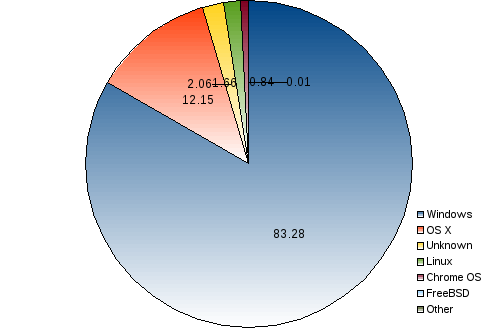

- #LINUX OS MARKET SHARE MAC OS#
- #LINUX OS MARKET SHARE INSTALL#
- #LINUX OS MARKET SHARE DRIVER#
- #LINUX OS MARKET SHARE SOFTWARE#

For each page view, we analyse the browser/operating system/screen resolution used and we establish if the page view is from a mobile device If you’re curios about how the data is collected, check out Statcounter’s FAQ page:Įvery month, we record billions of page views to these sites. While Linux’s share in North America dropped slightly, it has increased in all other parts of the world with Europe clearly leading at 2.23%. “Others” have also increased, pushing down both OS X and Windows. Not too bad for a quarter, I’d say.Ĭhrome OS has made a healthy jump from 1.72% to 2.09%, an increase of 21% and thus surpassing Linux. According to their latest data, Linux inched up to 1.97% by the end of the 1st quarter of this year. Market Share Increases 2%Īccording to StatCounter Globalstats Linux finished 2020 with a 1.93% market share. One way that difference shows up is with Linux, which often is installed on ordinary PCs that are used as servers, and not on systems that are built and marketed as servers.Quick look at Linux’s market share as a desktop operating system for the 1st quarter of 2021.
#LINUX OS MARKET SHARE SOFTWARE#
Shipments of operating system software differ from the shipments of servers themselves, Kusnetzky noted. 2021, Win10, Win8, Win7, WinXP, Linux, Mac, Chrome OS, Mobile. And because Linux was used more on servers than IDC originally predicted, the market researcher had to discount some shipments-for example, copies of Linux that were bundled with hardware such as network cards but never installed. you can read the long term trends of operating system usage. Fewer people used Linux on desktop computers than IDC originally calculated, he said, but some people used Linux-based machines both as workstations and servers. To account for Linux, IDC noted that it had to shift its methodology to accommodate the comparatively new operating system.įor example, the company has revised its 1999 Linux figures, Kusnetzky said.
#LINUX OS MARKET SHARE INSTALL#
Though Microsoft introduced its successor, Windows 95, in August 1995, companies with licenses for 3.1 continue to install it and send Microsoft the revenue, Kusnetzky said. One curiosity for the desktop market is how much Windows 3.1 still sells.
#LINUX OS MARKET SHARE MAC OS#
Linux, by contrast, had 1 percent and Mac OS had 4 percent. The situation was less varied in the desktop and laptop market, where Microsoft had 92 percent of the market, IDC said. While the number of Unix shipments stayed flat, revenue increased, he said, indicating that Unix is being used on increasingly powerful machines used to substitute for larger numbers of less powerful servers. "Sun was the bright spot," Kusnetzky said.

Open source software is in demand currently due to benefits such as flexibility, agility, speed, and cost-effectiveness.
#LINUX OS MARKET SHARE DRIVER#
The nature of Linux OS as an open source operating system is likely to be a major driver for the global Linux operating system market over the forecast period. And Compaq Computer's Tru64 Unix and the Santa Cruz Operation's Unix products declined in share. Linux Operating System Market 2019 Size, Share, Demand, Growth, Trends and Outlook. IBM's AIX and Hewlett-Packard's HP-UX were essentially flat. Unix slipped from 17 percent in 1999 to 14 percent in 2000, Kusnetzky said, while Novell NetWare slipped from 19 percent to 17 percent.Īmong Unix companies, he said, Sun Microsystems "saw significant growth" with its Solaris operating system. That's because Linux is very inexpensive.Īs Windows and Linux grabbed market share, all other server operating systems lost. IDC didn't release specific numbers, but Kusnetzky said Linux sales accounted for less than 1 percent of the total market. When revenues are examined instead of shipments, however, the picture is different. Industrywide, shipments of server operating systems grew 13 percent to 6.1 million, Kusnetzky said. Red Hat, Caldera Systems, Turbolinux and SuSE are the most prominent companies that sell Linux, an open-source operating system primarily used in servers. In 1999, Linux also was the fastest-growing server operating system. Linux grabbed 27 percent market share in 2000, up from 25 percent the previous year. Although the figures show that Windows shipments increased 20 percent, Linux outpaced it with a 24 percent increase. 1 threat, and the IDC numbers underscore that position. Microsoft CEO Steve Ballmer has acknowledged that Linux has become its No. Microsoft's Windows held 41 percent of the server OS market in 2000, up from 38 percent in 1999, according Dan Kusnetzky, an analyst at market researcher IDC. Microsoft still holds the lion's share of the server operating system market, but Linux shipments grew slightly faster than Windows did last year, according to a new report.


 0 kommentar(er)
0 kommentar(er)
